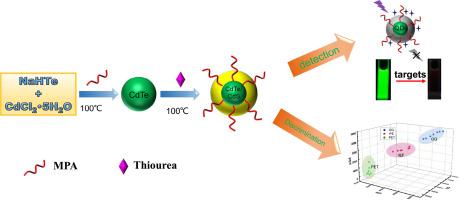Spectrochimica Acta Part A: Molecular and Biomolecular Spectroscopy ( IF 4.3 ) Pub Date : 2020-06-19 , DOI: 10.1016/j.saa.2020.118630 Wei Wei 1 , Jun Fan 1 , Yan Xia 1 , Xuebo Yin 1

|
Multi-target sensing completed with single chemosensor is cost-effective and pretty attractive for the analysis of multiple analytes in single sample. CdTe/CdS QDs show high fluorescence quantum yield as a probe for the sensing purpose, but only single target is often detected. Here we proposed that three kinds of different response mechanisms were realized using CdTe/CdS QDs with the simultaneous sensing of Fe3+, Cr2O72−, and IO3− as model. The specific binding affinity was used to detect Fe3+ with the photo-induced electron transfer (PET) mechanism. CdTe/CdS QDs showed intensive fluorescent response to Cr2O72− owing to the inner filter effect (IFE). IO3− is an oxidant and reacts to surface functional groups of CdTe/CdS QDs with oxidation quenching (OQ) mechanism for the selective detection of IO3−. The three targets recorded with the three mechanisms were obviously clustered even they were tested at different concentrations. Thus, the targets could be differentiated with each other through their different responses of PET, IFE, and OQ. The linear ranges for the selective detection of Fe3+, Cr2O72−, and IO3− were 5.0–100.0, 20.0–140.0 and 1.0–80.0 μM, with the limits of detection as low as 4.1, 9.7, and 0.9 μM, respectively. The proposed methods were satisfactorily applied to accurately detect Fe3+, Cr2O72−, and IO3− in real samples and it was further detected iodate and the total amount of iodine in table salt samples. The proposed multi-target detection strategy with the single fluorescence single from single QDs will stimulate the application of the other matrix with abundant response with enhance sensing efficiency.
中文翻译:

通过一种不同类型的机制,基于一个核-壳结构量子点的多模式荧光传感检测。
用单个化学传感器完成的多目标检测具有成本效益,并且对于分析单个样品中的多种分析物非常有吸引力。CdTe / CdS量子点显示出高荧光量子产率,可作为检测目的的探针,但通常仅检测到单个靶标。在这里,我们提出了这3种不同的反应机制,使用的CdTe / CdS的量子点与Fe的同时感测实现3+,铬2 ö 7 2-,和IO 3 -作为模型。使用特异性结合亲和力通过光诱导电子转移(PET)机制检测Fe 3+。CdTe / CdS QD对Cr 2 O 7 2-的荧光反应强烈由于内部滤镜效果(IFE)。IO 3 -是氧化剂并反应的CdTe表面的官能团/ CdS的量子点与氧化猝灭(OQ)机构,用于IO的选择性检测3 - 。即使以不同的浓度进行了测试,用这三种机理记录的三个目标也明显地聚集在一起。因此,可以通过PET,IFE和OQ对靶标的不同反应来区分靶标。选择性检测Fe 3+,Cr 2 O 7 2−和IO 3 −的线性范围检出限分别为5.0–100.0、20.0–140.0和1.0–80.0μM,分别低至4.1、9.7和0.9μM。所提出的方法是令人满意地施加到准确检测的Fe 3+,铬2 ö 7 2-,和IO 3 -实际样品中并且它进一步检测碘酸和碘的食盐样品中的总量。所提出的具有来自单个QD的单个荧光的单个目标的多目标检测策略将刺激具有丰富响应的其他矩阵的应用,并提高传感效率。











































 京公网安备 11010802027423号
京公网安备 11010802027423号